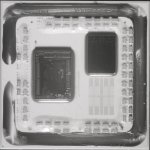Hi,
I finished my Ryzen 3700x loop with an Alphacool XPX Eisblock. My temps with slight OC (~4100MHz on all cores) is 90°C with Aida64 stability test.
My graphics card is cooled very well (<50°C), so I can rule out any problems with the loop itself.
I think I might have mounted it wrong. The document from Alphacool says to put the spacer on the spring side (makes sense to increase pressure) but this video does it different (makes no sense to me): https://www.youtube.com/watch?v=tR0n81N85xs#t=05m00s
So what's the right placement of the spacer? On the side of the spring, or under the plate?
Also, what is the reason of the nut anyway? Does it need to be tightened to the plate (it gets loose when I screw in the cooler to the back plate.
Or is the XPX cooler just bad for Ryzen 3000 due to the non centric positioning of the cores? Alternatives?
Greetings
Hendrik
I finished my Ryzen 3700x loop with an Alphacool XPX Eisblock. My temps with slight OC (~4100MHz on all cores) is 90°C with Aida64 stability test.
My graphics card is cooled very well (<50°C), so I can rule out any problems with the loop itself.
I think I might have mounted it wrong. The document from Alphacool says to put the spacer on the spring side (makes sense to increase pressure) but this video does it different (makes no sense to me): https://www.youtube.com/watch?v=tR0n81N85xs#t=05m00s
So what's the right placement of the spacer? On the side of the spring, or under the plate?
Also, what is the reason of the nut anyway? Does it need to be tightened to the plate (it gets loose when I screw in the cooler to the back plate.
Or is the XPX cooler just bad for Ryzen 3000 due to the non centric positioning of the cores? Alternatives?
Greetings
Hendrik






